check engine AUDI A8 2016 Owner's Manual
[x] Cancel search | Manufacturer: AUDI, Model Year: 2016, Model line: A8, Model: AUDI A8 2016Pages: 302, PDF Size: 75.68 MB
Page 219 of 302

Please refill Ad B lue . Range 1500 mi (2400 km )
This message appears when there is only eno ugh
Ad Blue lef t to d rive the distance indicated in the
d river information system . Fill the AdBlue.
AdBlue ,0 Refill AdBlue! No re start in 600 mi
( 1000 km )! See owner 's manual
This message appea rs when there is only eno ugh
Ad Blue left to drive the distance indicated in the
driver info rmation system . Fill the Ad Blue . Ot he r
wise the eng ine will not sta rt again if you s top it
once the d ist an ce in dicate d ha s been d riven. You
can also check t he remai ning dis tance in the on
board com puter.
Refill Ad Blue! No restart! See own-
er's manual
This message appears whe n the AdBlue ta nk is
empty . Fill the AdB lue. Otherwise you will not be
ab le to s tart the engine aga in once yo u stop it.
The AdBlue must be refilled when t he amount in
the tank has reached the minimum level
q page 217, Filling Ad Blue.
Incorrect filling /system malfunction
A message appears if the AdB lue tank was filled
with a fluid other than AdBlue and the system
has detected that the tan k was fi lled incor rect ly,
or if there is a system malfunction .
Ad Blue -I' Ad Blue: System fault! No restart in
600 mi (1000 km ). See owner's manual.
This message appears when it is only poss ible to
drive the d istance ind icated in the dr iver informa
tion system. Drive to t he nearest authorized Aud i
dealer o r authorized Aud i Serv ice Facility to have
the ma lfunction co rrected. Otherwise the engine
w ill not start agai n if you stop it once the d is
tance ind icated has been driven .
AdBlue: System fault No restart!
See owner's manual
This message appears if the system has detected
that the tank was filled inco rrectly o r that there
i s a malfunction . Drive immediately to the near
est authorized Aud i dea le r or authorized Aud i
Service Facility to have the malfunction correct-
Fuel and Refueling
ed. Ot herwise you wi ll not be able to star t the en
gine again once yo u stop it .
Filling AdBlue
Applies to : veh icles w ith selec tive catalytic re du ctio n (SCR)
Fig. 192 Right rear s ide of the ve hicle: re m ov ing t he A d Bl
u e cap
The Ad Blue tank open ing is located near t he d ie
sel tank opening. Add at least 1.5 gallons (5. 7L)
of Ad B lue . Thi s is the minim um amount requ ired
to ensure the system detects the refi lling and to
sta rt the eng ine. You can add a maxim um of 4
g allo ns ( 16L) .
Requireme nt: Th e reques t to add Ad Blue m ust
appear in the instrum ent clus te r disp lay .
.,. Switch t he ignit ion off.
.,. Open the tank door ¢ page 214 .
.,. Tu rn the cap on t he tank opening to the left to
remove ¢fig . 192.
.,. Fill t he A d Bl ue w ith the bottle ¢ page 218 or
t he ca n iste r ¢p age 218.
WARNING
A d Bl ue can irrita te the s kin, eyes an d re sp ira
tory system. If there is contact with t he f lui d,
fl ush immed iate ly w ith plenty of water . Con
sult a phys ician if necessary.
(D Note
- Only use Ad Blue th at con forms to t he
s tandar d ISO 2 22 41-1. Do not m ix any addi
tives with the Ad Blue and do not dilute it
w ith wate r.
- Ad Blue must not be filled in the diese l ta nk
and diese l fue l must not be filled in the
217
Page 222 of 302
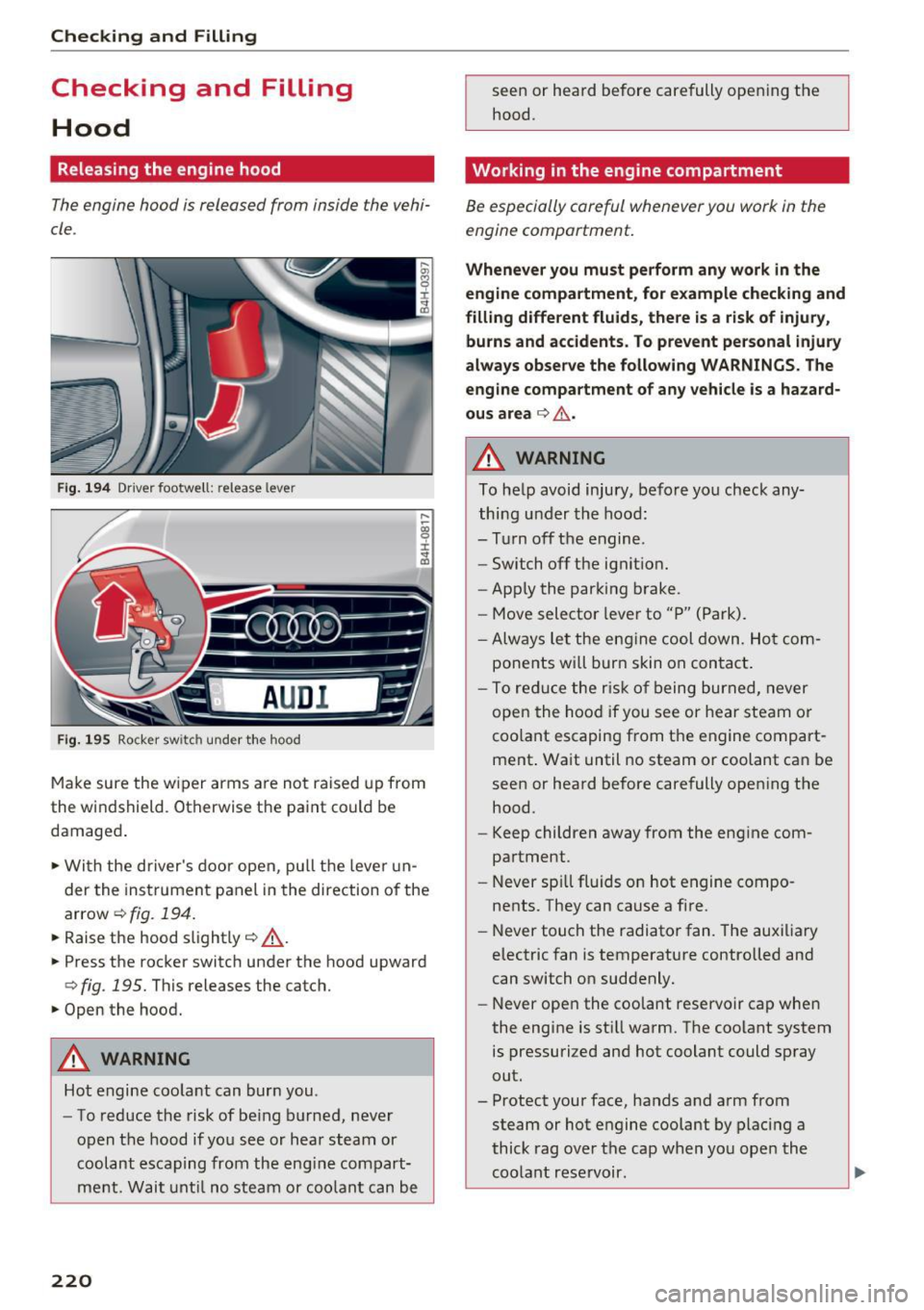
Checking and Filling
Checking and Filling
Hood
Releasing the engine hood
The engine hood is released from inside the vehi
cle .
Fig. 194 Driver footwell : release leve r
Fig. 195 Ro cker switc h under the hood
Make sure the wiper arms are not raised up from
the windshield . Otherwise the paint could be
damaged .
.. With the driver's door open, pu ll the lever un
der the instrument panel in the direction of the
arrow ¢
fig. 194.
.. Raise the hood slightly Q _A .
.. Press the rocker switch under the hood upward
Q fig. 195. This releases the catch.
.. Open the hood.
A WARNING
Hot engine coo lant can burn you .
- To reduce the risk of be ing burned, never
open the hood if you see or hear steam or
coolant escaping from the eng ine compart
ment. Wait unt il no steam or coolant can be
220
seen or heard before carefully open ing the
hood.
Working in the engine compartment
Be especially careful whenever you work in the
engine comportment.
Whenev er yo u mu st perform an y work in the
engin e compartment , for exampl e chec king and
filli ng d iffe rent fl uids , the re is a ri sk of injur y,
bu rn s and accid ent s. T o preven t perso na l injur y
alway s obse rve the foll owing WARNING S. The
en gine compartment o f an y v ehicl e is a haz ard
ou s a rea
Q _6 .
A WARNING
To help avoid injury, before you check any
thing under the hood:
- Turn off the engine .
- Switch off the ignit ion.
- Apply the parking brake.
- Move selector lever to "P" (Park).
-Always let the eng ine cool down. Hot com-
ponents will burn skin on contact .
-
-To redu ce the risk of being burned, never
open the hood if you see or hear steam or
coo lant escaping from the engine compart
ment . Wait until no steam or coolant can be
seen or heard before carefully opening the
hood.
- Keep children away from the engine com
partment .
- Never sp ill fluids on hot engine compo
nents. They can cause a fire.
- Never touch the radiator fan. The auxiliary
electric fan is temperature controlled and
can switch on suddenly.
- Never open the coolant reservoir cap when
the engine is sti ll warm. The coolant system
is pressurized and hot coolant could spray
out.
- Protect your face, hands and arm from
steam or hot engine coolant by placing a
thick rag over the cap when you open the
coolant reservoir .
Page 223 of 302

-Do not remove the engine cover under any
circumstances. This increases the risk of
burns.
- If work on the fuel system or the electrical
system is necessary:
- Always d isconnect the battery.
- Never smoke or work near heaters or open
flames. Flu ids in the engine compartment
could start a fire.
- Keep an app roved fire ext inguisher imme
d iate ly availab le.
- To avo id electr ical shock and personal injury
wh ile the eng ine is running or being started,
never touch:
- Ignition cables
- Other components of the high voltage
electronic ignition system.
- If you must perform a check or repa ir with
the engine running:
- First, fully apply the parking brake, move
selector lever to "P" (Park).
- Always use extreme caution to prevent
cloth ing, jewelry, or long hair from get
ting caught in the radiator fan, V-belts or
other mov ing parts, or from contacting
hot parts. Tie back ha ir before starti ng,
and do not wear clothi ng that will hang or
d roop into t he engine.
- Min imize exposu re to emission and chem i
cal hazards¢ .&.-
_& WARNING
California Proposition 65 Warn ing:
- E ngine exhaust, some of its constituents,
and certain vehicle components contain or
em it chem ica ls known to the St ate of C ali
f orn ia to cause cancer and bi rth de fects and
reproductive harm . In addition, certain flu
ids contained in ve hicles and certain prod
ucts of component wear contain or emit
Ch eck ing and Filling
chemicals known to the State of California
to cause cancer and birth defects or other
reproductive harm.
- Battery posts, term inals and related acces
sories contain lead and lead compounds,
chemicals known to the State of Californ ia
to cause cancer and reproductive harms.
Was h hands afte r handling .
([) Note
When adding flu ids, always make sure that
they are poured into the proper co nta iner or
fille r opening, otherwise serious damage to
vehicle systems w ill occur.
® For the sake of the environment
To detect leaks in time, inspect the veh icle
floor pan from unde rneath regularly . If you
see spots from oil or other veh icle fluids, have
your vehicle inspected by an authorized Audi
dealer.
Closing the engine hood
.,.. Pull the hood down un til the press ure from the
struts is reduced.
.,.. Let the hood
drop down and latch in p lace . Do
not try to push it shut;
it may fail to engage
¢ _& .
_& WARNING
--A hood that is not completely latched co uld
fly up and block your view while driv ing.
- When you close the engine hood, check it to
make sure the safety catch has properly en
gaged . The hood s hou ld be flush with the
sur rounding vehicle body parts.
- If you notice while driv ing that the hood is
not secured properly, stop at once and close
it.
-
221
Page 224 of 302

Checking and Filling
Engine compartment
Engine compartment overview
These are the most important items that you can check.
Fig. 196 Typical layout for con tainers and engine oil filler cap
2ij.A.97 Layout of the reservo ir, engine oil filling opening and oil dipst ick for the W12 engine
Page 225 of 302
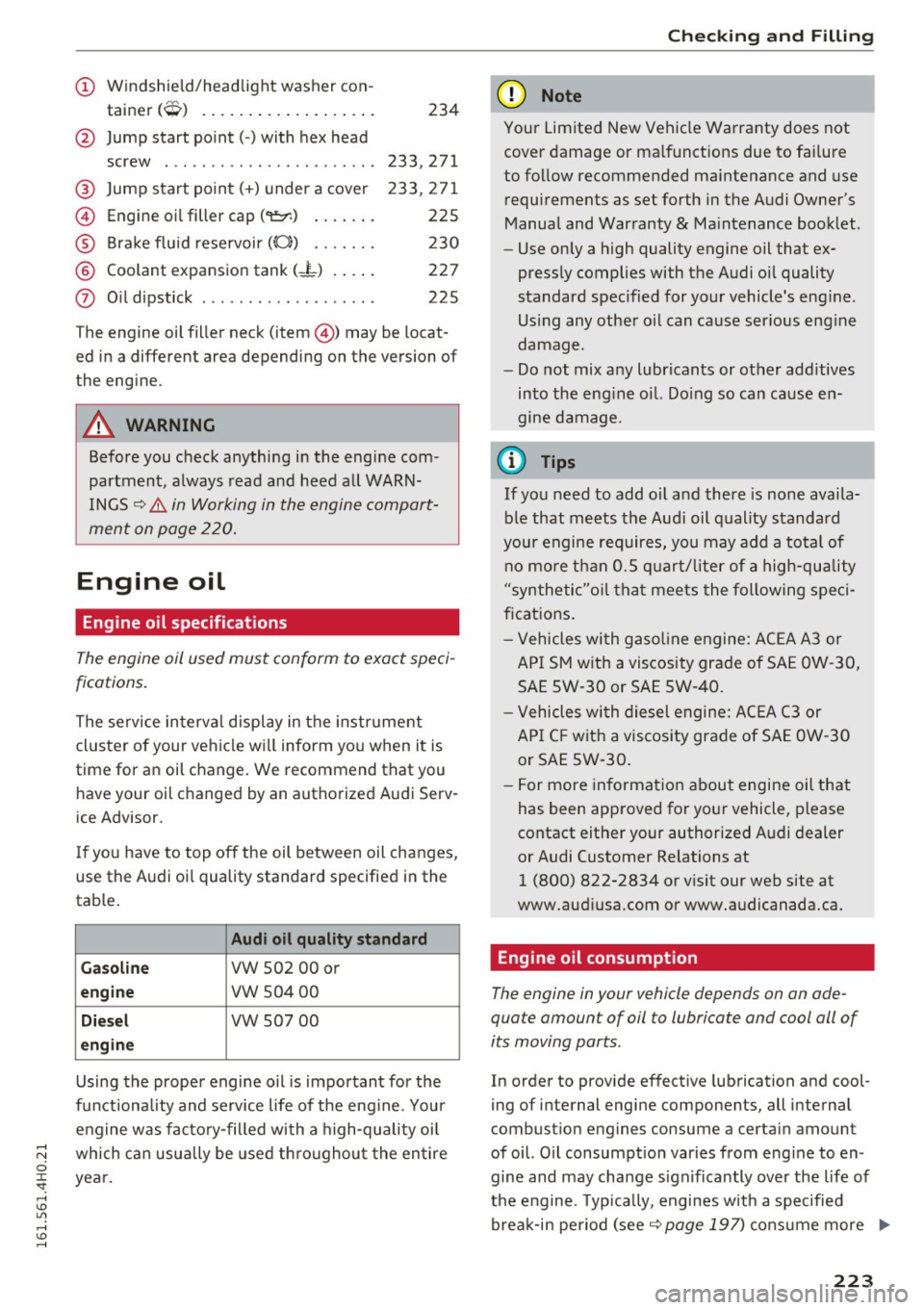
(!) Windshield/headlight washer con-
tainer
(O) ................. . .
@ Jump start point(-) with hex head
screw . ..................... .
@ Jump start point(+) under a cover
© Engine oil filler cap ("t!:r.) ...... .
® Brake fluid reservoir((();) ...... .
® Coolant expansion tank (-L) .... .
0 Oil dipstick .................. . 234
233,271
233,271 225
230
227
225
The engine oil filler neck (item@) may be locat
ed in a different area depending on the version of
the engine.
A WARNING
Before you check anything in the engine com
partment, always read and heed all WARN
INGS ¢
&. in Working in the engine compart
ment on page 220.
Engine oil
Engine oil specifications
The engine oil used must conform to exact speci
fications.
The service interval display in the instrument
cluster of your vehicle will inform you when it is
time for an oil change. We recommend that you hav e your oil changed by an authorized Audi Serv
ice Advisor.
I f you have to top off the oil between oil changes,
use the Audi oi l quality standard specified in the
table.
Audi oil quality standard
Gasoline
VW 502 00 or
engine vw 50400
Diesel vw 507 00
engine
Using the proper engine oil is impo rtant for the
functiona lity and service life of the eng ine. Your
engine was factory-filled with a high-quality oil
;:;:: which can usually be used throughout the entire
0
~ year.
,....,
(D Note
Your Limited New Vehicle Warranty does not
cover damage or malfunctions due to failure
to follow recommended maintenance and use
requirements as set forth in the Audi Owner's
Manual and Warranty
& Maintenance booklet .
- Use only a high quality engine oil that ex-
pressly complies with the Audi oil quality
standard spec ified for your vehicle's eng ine.
Us ing any other oil can cause ser ious eng ine
damage.
- Do not mix any lubricants or other additives
into the eng ine oi l. Do ing so can cause en
gine damage.
(D Tips
If you need to add oil and there is none availa
ble that meets the Aud i oil quality standard
your engine requires, you may add a total of no more than 0.5 quart/liter of a high-quality
"synthetic"oi l that meets the following speci
fications.
- Vehicles with gasoline engine: ACEA A3 or
API SM with a viscosity grade of SAE OW-30,
SAE SW -30 or SAE 5W-40.
- Vehicles with diesel engine: ACEA C3 or
API C F with a viscosity grade of SAE OW-30
or SAE SW-30.
- For more information about engine oil that
has been approved for your vehicle, please
contact either your authorized Audi dealer
or Audi Customer Relations at
1 (800) 822-2834 or visit our web site at
www.audiusa.com or www.audicanada.ca.
Engine oil consumption
The engine in your vehicle depends on an ade
quate amount of oil to lubricate and cool all of
its moving parts.
In order to provide effective lubrication and cool
ing of internal engine components, all internal
combust ion engines consume a certain amount
of oil. O il consumption varies from eng ine to en
gine and may change significantly over the life of
the engine. Typ ically, engines w ith a specified
break-in period (see ¢
page 197) consume more ""
223
Page 226 of 302
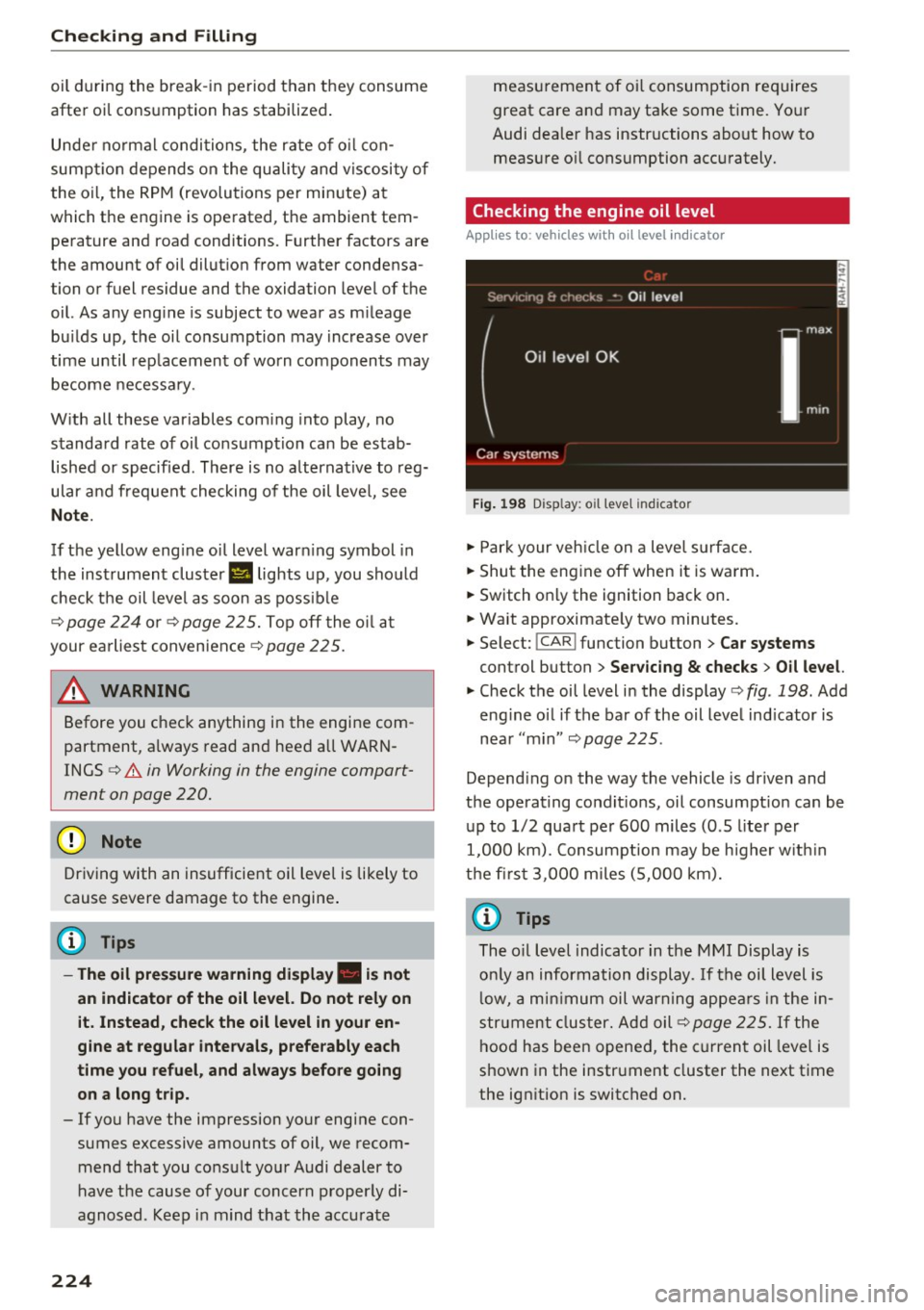
Check ing and F illing
oil du ring the break -in period than they consume
after oil consumption has stabilized .
Unde r no rmal condi tions, the rate of o il con
sumpt ion depends on the quality and viscosity of
the oi l, the RPM (revolutions per minute) at
which the engine is operat ed, the ambient tem
perature and road cond itions . Further factors are
the amount of oil dilut ion from water condensa
tion or fuel residue and the oxidation level of the
oil. As any eng ine is subject to wear as m ileage
bu ilds up, the oil consumption may increase over
time until rep lacement of worn components may
become necessa ry .
W ith all these variables com ing into play, no
standard rate of oil consumpt ion ca n be estab
lished or specified . There is no a lternative to reg
ular and frequent checking of the oil leve l, see
Note .
If the ye llow eng ine oil level war ning symbol in
the instrument cluster
II lights up, you should
check t he oil leve l as soon as possib le
¢
page 224 o r ¢ page 225. Top off the o il at
your ea rliest convenience ¢
page 225.
A WARNING
Before you check anything in the engine com
partment, a lways read and heed a ll WARN
INGS ¢.&
in Working in the engine compart
ment on page 220.
(D Note
Driving with an insufficient oil level is likely to
cause severe damage to the engine .
@ Tips
-The oil pres sure warning display. i s not
an indicator of the o il level. Do not rely on
i t. Instead , check the oil level in your en
gine at regular intervals, preferably ea ch
time you refuel , and always befo re going
on a long trip.
- If you have the impression your engine con
sumes excessive amounts of oil, we recom
mend that you co nsul t yo ur Audi dealer to
have the cause of your concern p roperly di
agnosed . Keep in mind that the acc urat e
224
meas urement of oi l consumption re quires
great care and may take some t ime. Yo ur
Audi dea ler has instructions about how to
meas ure o il consumption acc urately.
Checking the engine oil level
App lies to: vehicles wi th oil level indicato r
Fig. 198 Disp lay : o il leve l ind icato r
.,. Par k your veh icle on a leve l su rface.
.,. Shut the eng ine off when it is warm .
.,. Switch o nly the ignition back on.
.,. Wait approximate ly two minutes.
.,. Select:
!CAR ! function button > Car systems
control button > Servicing & checks > Oil le vel.
.,. Check the oil level in the display c> fig . 198 . Add
eng ine oi l if the ba r of the oil leve l ind icator is
nea r "m in"
¢ page 225 .
Depend ing on the way the vehicle is driven and
the operating cond it ions, oil consumpt io n can be
u p to 1/2 qua rt pe r 600 miles (0 .S liter per
1,000 km). Consumpt ion may be h igher w it hi n
the first 3, 000 mi les (5,00 0 km).
(D Tips
The o il level indicato r in the MMI Display is
o nl y an information display. If t he oi l level is
l ow, a m inimum oil w arn ing appea rs in the in
str ument clus ter. Ad d oil ¢
page 225. If the
hood has been opened, the curren t oil level is
shown in the instrument cluster the next t ime
the ignition is switched on .
Page 227 of 302
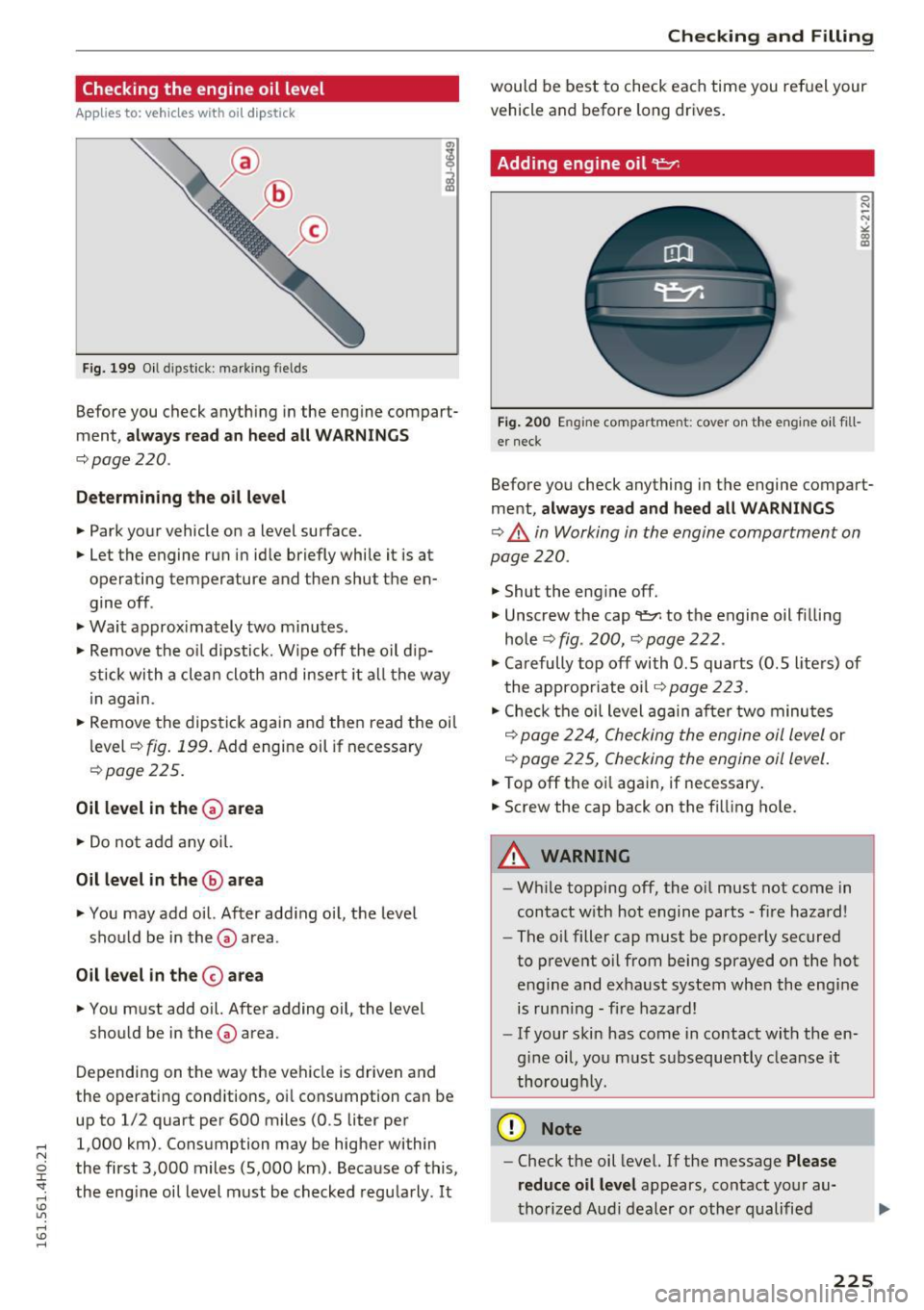
Checking the engine oil level
Applies to: vehicl es wit h oil dipst ick
Fig . 199 O il dips tick: marking fields
Before you check anyth ing in the engine compart
ment,
always read an heed all WARN INGS
r:::,;, page 220.
Determining the oil level
.. Park yo ur vehicle on a level sur face .
.. Let the engine run i n idle briefly while it is at
operating temperature and then shut th e en
gine off .
.,. Wait approx ima tely two minu tes.
.,. Remove th e oil dipstick. Wipe off the o il dip
s tick with a clea n cloth an d inse rt it a ll the way
in again.
.. Remove the dips tic k again and the n read t he oil
l evel
<=,> fig . 199. Add engi ne oil if necessa ry
r:::,;, page 225 .
Oil level in the G) area
.,. Do no t ad d any oil.
Oil level in the@ area
.. You may add o il. A fter add ing o il, t he leve l
sho uld be in the
G) area.
Oil level in the@ area
.. You m ust add oil. After adding oil, the level
sho uld be in the
(v area.
D epending on the way the ve hicl e is driven and
the o perati ng cond itions, oi l cons umption can be
up to 1/2 quart per 600 miles (0 .5 liter pe r
1,000 km) . Consumption may be higher within
the first 3,000 miles (5,000 km). Beca use of t his,
the eng ine oil level must be checked regu larly. It
Checking and Filling
would be best to check eac h time you ref uel your
vehicle and before long dr ives .
Adding engine oil~
0 N
-N ~ 00 Cl)
Fig. 200 Engine compartm ent: cove r on th e e ngine oil fill
e r n eck
Befo re you check anything in the engine compart
me nt,
always read and heed all WARNINGS
r:::,;, .&. in Working in th e engine compartment on
pag e 220.
.. Shut the engine off.
.,. Unscrew the cap~ to the engine oil f illin g
hole
r:::,;, fig . 200, r:::,;, page 222 .
.,. Ca refully top off with 0.5 quarts (0.5 lite rs) of
t he approp ria te o il
r:::,;, page 223 .
.. Che ck th e oi l level aga in a fter two minu tes
r:::,;, page 22 4, Che cking the engine oil level or
r:::,;, page 22 5, Checking the engine oil level.
.. Top off the oi l again, if necessary .
.. Screw the cap back on the f illing ho le .
A WARNING
-- W hile topping off, the o il must not come in
contact w ith hot engine parts - f ire hazard !
- The oi l filler cap must be p roper ly secured
t o preve nt o il from being sprayed o n th e hot
en gine and exha ust system w hen the eng ine
is run ning - fi re hazard !
- If you r ski n has come in contac t with the en
g in e oil, you m ust s ubsequ ently cleanse it
t horo ug hl y.
(D Note
- Check t he oil level. If the m essage Please
reduce oil level
a ppears , contact yo ur au
t ho rize d Au di deale r or othe r qualifi ed
225
Page 228 of 302

Check ing and F illing
workshop to have excess oil ext racted if
necessary.
- Audi does not recommend the use of oil
addit ives. They may dam age the eng ine
and ad ve rs ely affe ct your New Vehicle
W arranty .
@ For the sake of the environment
-Under no circ umstances can the o il come in
contact with the sewage network or the soil.
- Observe and follow legal regu lations when
disposing of empty oil containers.
Changing the engine oil
We recommend that hove your oil changed by on
authorized Audi dealer or a qualified service sta
tion .
Before you check anyth ing in the eng ine compart
ment,
a lway s read and heed all WARNINGS¢.&.
in Working in the engine comportment on
page 220.
The engine oil must be changed accord ing to the
i n tervals specified in your Wa rranty
& Mainte
nance booklet . This is very important because the
lubricat ing properties of oi l diminish gradually
during normal vehicle use.
Under some circ umstances the engine oi l should
be changed more frequently. Change oil more of
ten if yo u drive most ly short distances, operate
the vehicle in dusty areas or under predominantly
stop-and-go traffic cond it ions, or have your vehi
cle where temperatu res remain below freezing
for extended periods .
Detergent additives in the oil will make fresh oil
look dark after the engine has been running for a
short t ime. Th is is normal and is not a reason to
cha nge the oil more often than recommended.
Because of the prob lem of proper disposal, along
with the special tools and necessary expertise re
qu ired, we strongly recommend that you have
your oil changed by an authorized
Audi dealer or
a qualified se rvice station .
If you choose to change your o il yourself , please
note the following important information:
226
A WARNING
--
To reduce the risk of persona l injury if you
must change the eng ine oil in your vehicle
yourself:
- Wea r eye protect ion.
- To reduce the r is k of b urns from hot engine
oil, let the engine cool down to the touch.
- When removing the oil drain plug with your
fingers, stay as far away as possible. Always
keep your forearm parallel to the ground to he lp prevent hot oil from run ning down your
arm.
- Drain the oil into a container designed fo r
this purpose, one la rge enough to hold at
least the tota l amount of oil in you r engine.
- Engine oil is poisonous. Keep it well out of the reach of children .
- Continuous contact with used engine o il is
ha rmf ul to your skin . Always protect your
skin by washi ng oil off thoroughly with soap
a nd water.
(D Note
Never mix oil additives with you r engine oil.
These add itives can damage your e ngine and
adverse ly affect yo ur Audi Limi ted New Vehi
cle War ranty.
@ For the sake of the environment
- Be fore chang ing your oi l, first make sure
you know where you can p roperly dispose of
t h e used oil.
- Always dispose of used e ngine o il properly .
Do not dump it on gard en so il, wooded
areas, into open streams or down sewage
drains.
- Recycle used e ngine o il by ta king it to a used
eng ine oil collect ion fac ility in yo ur area, or
c ont act a servi ce st ation.
Page 229 of 302
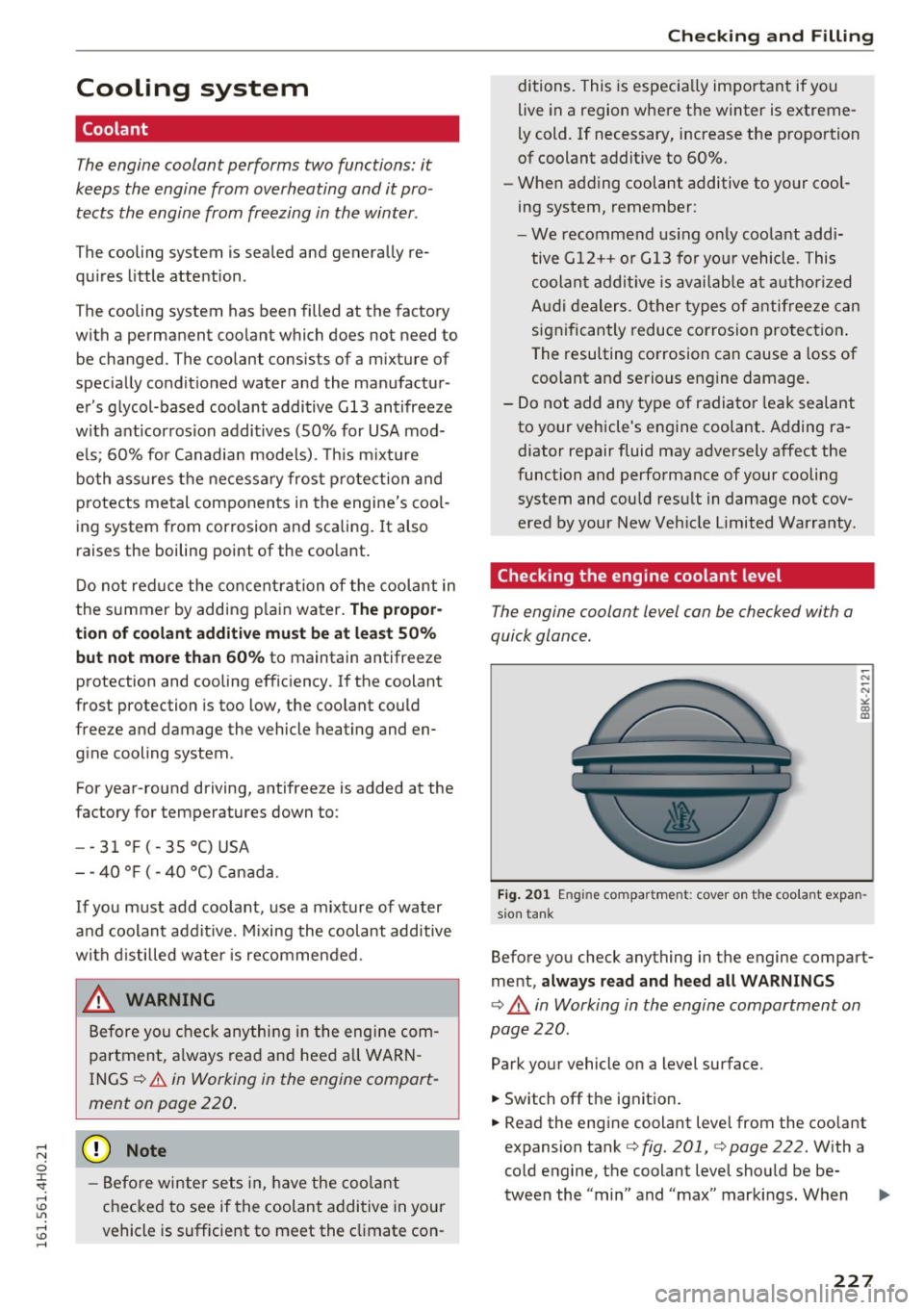
Cooling system
Coolant
The engine coolant performs two functions: it
keeps the engine from overheating and it pro
tects the engine from freezing in the winter .
The cooling system is sealed and generally re
quires little attention.
T he cooling system has been filled at the factory
with a permanent coolant which does not need to
be changed . The coolant consists of a mixture of
specially condit ioned water and the manufactur
er's glycol-based coolant additive Gl3 antifreeze
with anticorrosion additives (SO% for USA mod
e ls; 60% for Canadian mode ls). This m ixture
both ass ures the necessa ry frost protection and
protects metal components in the engine's coo l
ing system from corrosion and scaling .
It also
raises the boiling point of the coolant.
Do not red uce the concent ration of the coolant in
the summer by adding p lain water.
The propor
tion of coolant addit ive mu st be at least 50 %
but not more than 60 %
to mainta in antifreeze
protection and cooling efficiency. If the coolant
frost protection is too low, the coolant could
freeze and damage the vehicle heating and en
g ine cooling system .
For year-round driving, antifree ze is added at the
factory for temperatures down to :
- -31° F(- 3S°C)USA
- - 40 ° F ( - 40 °C) Canada.
If you must add coolant, use a m ixture of water
and coolant addit ive. M ixing the coolant additive
with d istilled water is recommended .
_& WARNING
Before you check anythi ng i n t he engine com
partment, always read and heed all WARN
INGS
¢ .&. in Working in the engine compart
ment on page 220 .
(D Note
-Befo re winter se ts in, have the coo lant
checked to see if the coolant additive in your
vehicle is sufficient to meet the cl imate con -
Check ing and Filling
ditions. This is especially important if you
live in a region where the winter is extreme
ly cold. If necessary, increase the proportion
of coolant additive to 60%.
- When adding coolant additive to your cool
ing system, remember :
- We recommend us ing only coolant add i
tive Gl2+ + or Gl3 for yo ur vehicle. This
coolant addit ive is avai lab le at aut horized
A udi dealers . O ther types of antifree ze can
significantly reduce corrosion pro tect ion .
The resulting corrosion can cause a loss of
coolant and serious engine damage.
- Do not add any type of radiator leak sealant
to your vehicle's engine coolant. Adding ra
diator repair fluid may adversely affect the
function and performance of your cooling system and cou ld resu lt in damage not cov
ered by your New Veh icle Limited Warra nty .
Checking the engine coolant level
The engine coolant level can be checked with a
quick glance.
Fi g. 2 01 Engin e compar tmen t: cover o n th e coo lant expan
sion t ank
Before you check anything in the engine compart
ment,
always read and heed all WARNINGS
¢ A in Working in the engine compartment on
page 220 .
Park your vehicle on a level surface .
.,. Switch off the ignition .
.,. Read the engine coolant level from the coo lant
expansion tank
¢ fig . 201, ¢page 222. With a
cold engine, the coolant level should be be-
tween the "min" and "max" markings. When .,.
227
Page 230 of 302
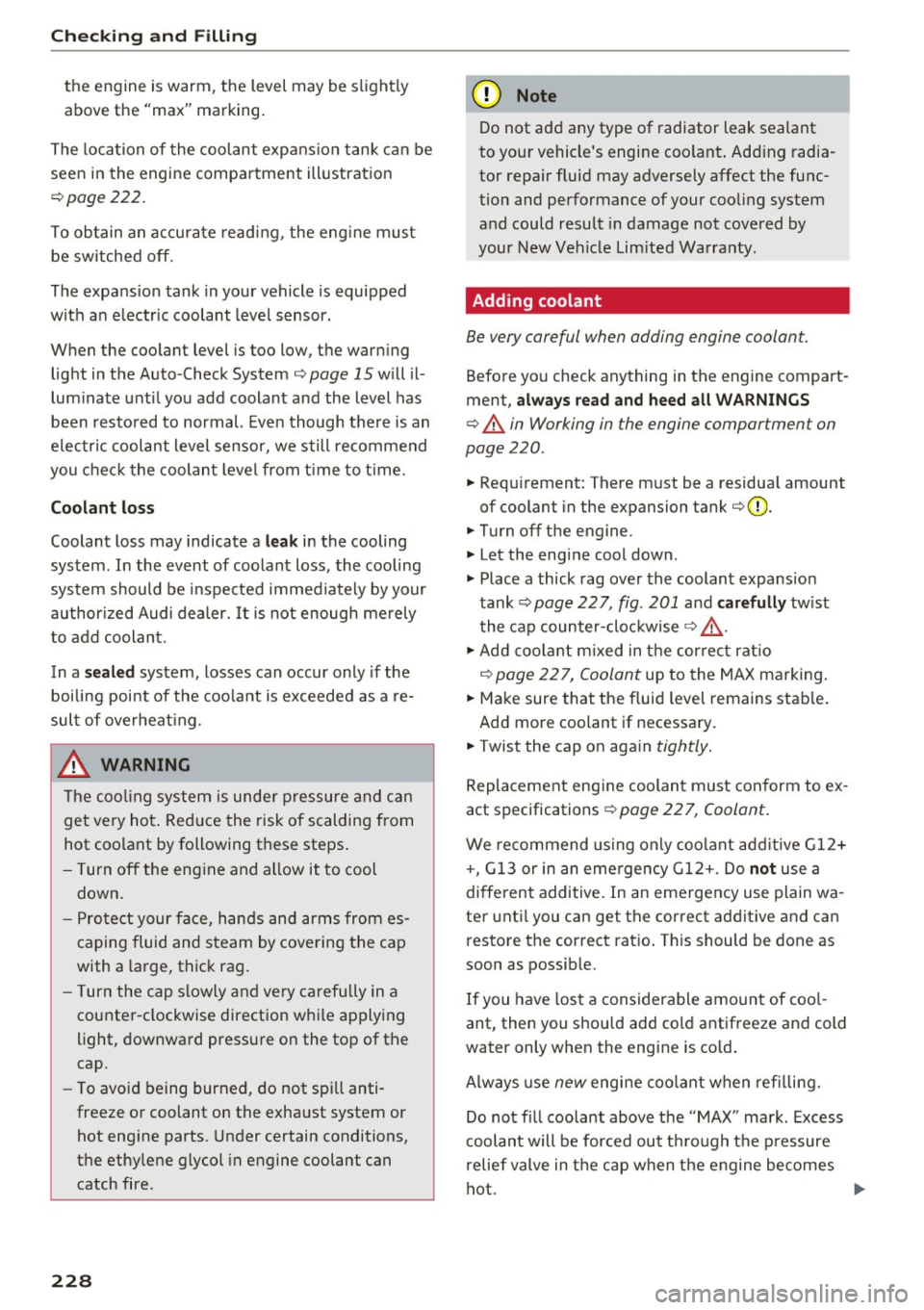
Checking and Filling
the engine is warm, the level may be slightly above the "max" marking.
The location of the coolant expansion tank can be
seen in the engine compartment illustration
¢ page 222.
To obtain an accurate reading, the engine must
be switched off.
The expansion tank in your vehicle is equipped
with an electric coolant level sensor.
When the coolant level is too low, the warning
light in the Auto-Check System¢
page 15 will il
luminate until you add coolant and the level has
been restored to normal. Even though there is an
electric coolant level sensor, we still recommend
you check the coolant level from time to time .
Coolant loss
Coolant loss may indicate a leak in the cooling
system . In the event of coolant loss, the cooling
system should be inspected immediately by your
authorized Audi dealer.
It is not enough merely
to add coolant.
In a
sealed system, losses can occur only if the
boiling point of the coolant is exceeded as a re
sult of overheating.
_& WARNING
The cooling system is under pressure and can
get very hot. Reduce the risk of scalding from
hot coolant by following these steps.
- Turn off the engine and allow it to cool
down.
- Protect your face, hands and arms from es
caping fluid and steam by covering the cap
with a large, thick rag.
- Turn the cap slowly and very carefully in a
counter-clockwise direction while applying
light, downward pressure on the top of the
cap.
- To avoid being burned, do not spill anti
freeze or coolant on the exhaust system or
hot engine parts. Under certain conditions,
the ethylene glycol in engine coolant can
catch fire.
228
(D Note
Do not add any type of radiator leak sealant
to your vehicle's engine coolant. Adding radia
tor repair fluid may adversely affect the func
tion and performance of your cooling system
and could result in damage not covered by
your New Vehicle Limited Warranty .
Adding coolant
Be very careful when adding engine coolant.
Before you check anything in the engine compart
ment,
always read and heed all WARNINGS
¢.& in Working in the engine compartment on
page 220 .
.. Requirement: There must be a residual amount
of coolant in the expansion tank ¢(D .
.. Turn off the engine .
.. Let the engine cool down .
.. Place a thick rag over the coolant expansion
tank ¢
page 22 7, fig. 201 and carefully twist
the cap counter-clockwise ¢&, .
.,. Add coolant mixed in the correct ratio
r::!> page 22 7, Coolant up to the MAX marking.
.. Make sure that the fluid level remains stable.
Add more coolant if necessary .
.. Twist the cap on again
tightly.
Replacement engine coolant must conform to ex
act specifications ¢
page 22 7, Coolant.
We recommend using only coolant additive G12+
+, G13 or in an emergency G12+ . Do
not use a
different additive. In an emergency use plain wa
ter until you can get the correct additive and can
restore the correct ratio. This should be done as
soon as possible.
If you have lost a considerable amount of cool
ant, then you should add cold antifreeze and cold
water only when the engine is cold.
Always use
new engine coolant when refilling.
Do not fill coolant above the "MAX" mark . Excess
coolant will be forced out through the pressure
relief valve in the cap when the engine becomes
hot.
~